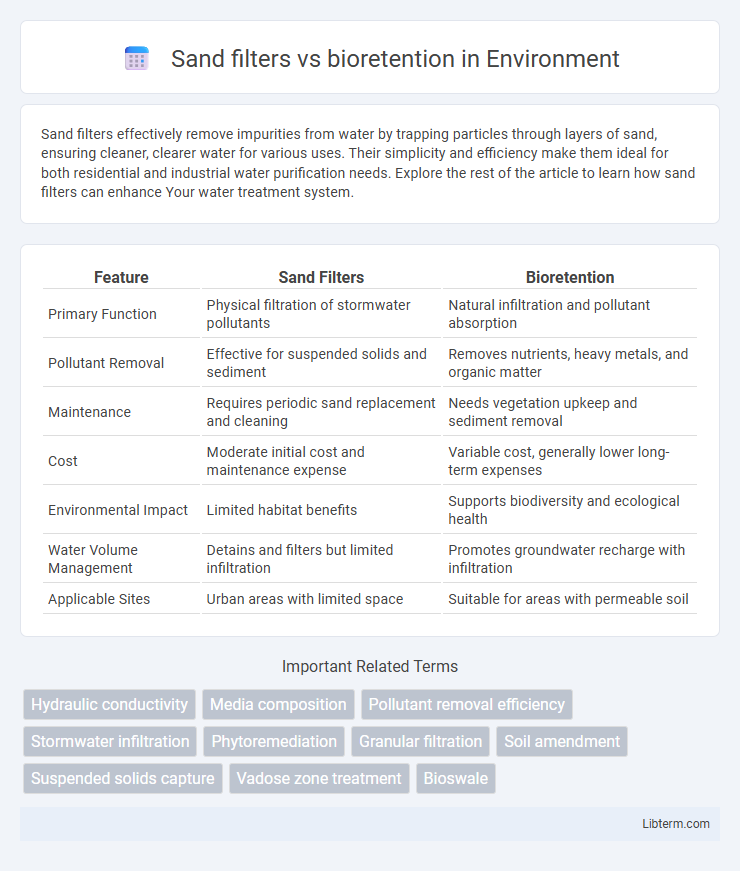Sand filters effectively remove impurities from water by trapping particles through layers of sand, ensuring cleaner, clearer water for various uses. Their simplicity and efficiency make them ideal for both residential and industrial water purification needs. Explore the rest of the article to learn how sand filters can enhance Your water treatment system.
Table of Comparison
| Feature | Sand Filters | Bioretention |
|---|---|---|
| Primary Function | Physical filtration of stormwater pollutants | Natural infiltration and pollutant absorption |
| Pollutant Removal | Effective for suspended solids and sediment | Removes nutrients, heavy metals, and organic matter |
| Maintenance | Requires periodic sand replacement and cleaning | Needs vegetation upkeep and sediment removal |
| Cost | Moderate initial cost and maintenance expense | Variable cost, generally lower long-term expenses |
| Environmental Impact | Limited habitat benefits | Supports biodiversity and ecological health |
| Water Volume Management | Detains and filters but limited infiltration | Promotes groundwater recharge with infiltration |
| Applicable Sites | Urban areas with limited space | Suitable for areas with permeable soil |
Introduction to Stormwater Management
Sand filters and bioretention systems serve as essential stormwater management practices designed to improve water quality and reduce runoff volume. Sand filters utilize layers of sand and other media for physical filtration and sediment removal, effectively targeting particulate pollutants. Bioretention employs soil and vegetation to facilitate infiltration, nutrient uptake, and microbial activity, mimicking natural hydrological processes to treat stormwater.
What Are Sand Filters?
Sand filters are engineered systems designed to remove suspended solids, pollutants, and pathogens from stormwater runoff through physical filtration and biological processes. Typically constructed with layers of sand and gravel, these filters trap contaminants as water percolates downward, promoting infiltration and improving water quality. Sand filters are widely used in urban stormwater management to reduce sediment loads and mitigate pollution before discharge into natural water bodies or groundwater recharge areas.
What Is Bioretention?
Bioretention is an engineered stormwater management practice designed to mimic natural hydrologic processes by filtering runoff through a soil and plant system that removes pollutants and promotes groundwater recharge. Unlike sand filters, which primarily rely on sand media to trap sediments, bioretention systems incorporate vegetation and organic layers to enhance nutrient uptake, microbial activity, and infiltration rates. This approach provides effective treatment for urban stormwater by improving water quality and reducing peak flow volumes.
Key Design Differences
Sand filters employ a uniform sand medium for rapid filtration and are designed primarily for sediment removal and basic pollutant capture, whereas bioretention systems utilize engineered soil mixes with organic matter to promote enhanced biological treatment and stormwater infiltration. Sand filters typically include underdrain systems for efficient drainage and require periodic media replacement, while bioretention relies on plant uptake, microbial activity, and evapotranspiration, reducing maintenance frequency. Design parameters for sand filters focus on flow rates and media depth, contrasting with bioretention's emphasis on soil permeability, vegetation selection, and hydraulic loading capacity.
Filtration Efficiency Comparison
Sand filters typically achieve filtration efficiencies ranging from 70% to 90% for suspended solids, making them highly effective for stormwater treatment. Bioretention systems provide comparable filtration performance, with pollutant removal rates often between 60% and 85%, benefiting from soil media and vegetation that enhance nutrient uptake and microbial degradation. Both technologies serve distinct roles in stormwater management, with sand filters excelling in rapid sediment removal and bioretention offering broader pollutant attenuation through biological processes.
Maintenance Requirements
Sand filters require routine inspection to remove accumulated sediment and ensure consistent filtration efficiency, typically involving backwashing and media replacement every few years. Bioretention systems demand regular maintenance of vegetation, monitoring soil conditions, and removal of debris to sustain pollutant uptake and prevent clogging. Effective maintenance for both systems is crucial to prolong functionality and optimize stormwater treatment performance.
Cost Analysis
Sand filters generally incur lower initial installation costs compared to bioretention systems due to simpler construction and fewer material requirements. However, ongoing maintenance expenses for sand filters can be higher, driven by frequent media replacement and clogging issues, while bioretention benefits from natural vegetation that reduces upkeep costs over time. Evaluating the total lifecycle cost reveals that bioretention might offer greater long-term economic advantages, especially in urban stormwater management projects.
Environmental Impact and Water Quality
Sand filters effectively remove suspended solids, nutrients, and pathogens, significantly improving water quality by reducing pollutants before discharge into natural water bodies. Bioretention systems enhance environmental impact by promoting infiltration, supporting microbial activity, and facilitating pollutant degradation through soil and vegetation, thus promoting groundwater recharge and reducing urban runoff volumes. Compared to sand filters, bioretention provides superior benefits for ecosystem health by improving biodiversity and reducing thermal pollution in receiving waters.
Suitability for Urban and Rural Settings
Sand filters excel in urban areas due to their compact footprint and efficient removal of suspended solids and pollutants from stormwater runoff, making them ideal for limited-space environments. Bioretention systems suit both urban and rural settings by promoting natural infiltration and supporting diverse vegetation, aiding groundwater recharge and habitat creation. Their flexibility in design allows bioretention to handle variable runoff volumes typical of rural landscapes while enhancing aesthetic and ecological benefits in cities.
Choosing the Right System: Factors to Consider
Selecting between sand filters and bioretention systems depends on site conditions, treatment goals, and maintenance capacity. Sand filters excel in removing suspended solids and require less space, suitable for urban areas with limited land availability. Bioretention systems offer enhanced pollutant removal through natural processes and provide habitat benefits but need larger areas and regular upkeep.
Sand filters Infographic

 libterm.com
libterm.com